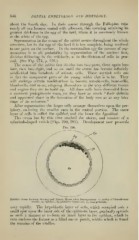Page 536 - My FlipBook
P. 536
546 DENTAL EMBRYOLOGY AND HISTOLOGY.
about the fourth day. In their course through the Fallopian tube
nearly all ova become coated with albumen, this covering attaining its
greatest thickness in the egg of the tbwl, where it is commonly known
as the white of the egg.
Segmentation in the ovum of the rabbit occurs throughout the whole
structure, but in the egg of the fowl it is less complete, being confined
to one point on the surface. In the mammalian egg the process of seg-
mentation is in all probability by segmentation of the nucleus first,
division following in the cell-bodv, as in the division of cells in gen-
eral. (See Fig. 274, p. 536.)
The ovum of the rabbit first divides into two parts, these again into
four, then into eight, and so on until the ovum has become infinitely
subdivided into hundreds of minute cells. These myriad cells are
in fact the component parts of the young rabbit that is to be. They
will undergo certain modifications to become muscle-cells, bone-cells,
blood-cells, and so on, adapting themselves to the very different tissues
and organs they are to build up. All these cells have descended from
a common protoplasmic mass, yet they have as much " their definite
and appointed share in the formation of the body no^^' as at any later
stage of its existence."
After segmentation the larger cells arrange themselves upon the per-
iphery, enclosing the smaller ones in the central portion. The outer
layer of cells is called the epihlast, and the inner the Jiijpoblast.
The ovum has by this time reached the uterus, and consists of a
spherical-shaped vesicle (Figs. 290, 291). Development now proceeds
Fig. 290.
Rabbit's Ovum between Seventy and Ninety Hours after Impregnation : hi; cavity of blastodermic
vessels ; ep, epiblast ; lij/, primitive hypoblast ; zp, zona pellucida.
very rapidly. The hypoblastic layer of cells, which occupied only a
small spot upon the inner side of the epiblastic layer, gradually spreads
in such a manner as to form an inner layer to the epiblast, which in
turn encloses the former as a blind sac or pouch, within which is found
the remains of the vitellus.


